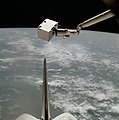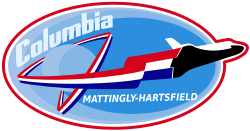STS-4
| Missionsemblem | |||||
|---|---|---|---|---|---|
 | |||||
| Missionsstatistik | |||||
| Missionsnavn: | STS-4 | ||||
| Rumagentur: | NASA | ||||
| Rumfærge: | Columbia (4) | ||||
| Antal besætningsmedlemmer: | 2 | ||||
| Affyringsrampe: | LC-39A (KSC) | ||||
| Opsendelse: | 27 juni 1982, 16:00:00 UTC | ||||
| Landing: | 4 juli 1982, 16:04:46 UTC | ||||
| Landet på: | Edwards Air Force Base | ||||
| Varighed: | 7 dage, 1:9:31 | ||||
| Foto af besætningen | |||||
 (V-H) Besætningsmedlemmer Thomas K. Mattingly og Henry W. Hartsfield. | |||||
| Navigation | |||||
| |||||
STS-4 (Space Transportation System-4) var NASAs fjerde rumfærge-mission. Opsendt 27. juni 1982 og vendte tilbage den 4. juli 1982.
Den var den fjerde og sidste test af rumfartøjet og den sidste flyvning med kun 2 besætningsmedlemmer.
Missionen medbragte dog det første kommercielle eksperiment og klassificeret militær last for Forsvarsministeriet (USA) (DoD).
Hovedartikler:
Missionen
STS-4 var ligesom STS-1, STS-2 og STS-3 en test-mission. Astronauterne gennemførte medicinske eksperimenter på sig selv som en del af forsøg fra de medbragte eksperimenter. Astronauterne tog også billeder af lyn i Jordens atmosfære.
Den fjernstyrede robot-arm på rumfærgen blev benyttet til at flytte overvågningssystemet IECM rundt om rumfærgen. IECM skulle måle hvilke partikler og gasser rumfærgen afgiver i rummet.
Missionen medbragte følgende materialer til forsøg (nyttelast):
- Hemmelig militær last.
- Nyttelasten Get Away Specials med forsøg fra studerende:
- 9 eksperimenter fra Utah State University.
- Første kommercielle eksperiment (Continuous Flow Electrophoresis System (CFES).
- Monodisperse Latex Reactor (MLR).
- Induced Environment Contamination Monitor (IECM).
- 2 Shuttle Student Involvement Program (SSIP).
Kort efter opsendelsen bliver Løfteraketterne (SRB) smidt af, løfteraketterne der normalt bliver genbrugt, gik tabt da faldskærmene ikke foldede sig ud ved nedstigningen.
Besætning
De to testpiloter sad i katapultsæder.

 Thomas K. Mattingly (Kaptajn, Apollo 16-veteran)
Thomas K. Mattingly (Kaptajn, Apollo 16-veteran)
 Henry W. Hartsfield (Pilot)
Henry W. Hartsfield (Pilot)
Vægt
- Kredsløbsfartøj (ved opsendelse): 109.616 kg.
- Kredsløbsfartøj (ved landing): 94.774 kg.
- Last: 11.109 kg.
- STS-4 opsendelsen.
- Robot-armen løfter Induced Environment Contamination Monitor (IECM)
- Astronauterne hilser på præsident Ronald Reagan og Nancy Reagan efter landing.
Eksterne henvisninger
- STS-4 NASA (engelsk)
| ||||||||
Medier brugt på denne side
Columbia Space Shuttle astronauts Commander Thomas K. Mattingly, foreground, and Pilot Henry W. Hartsfield salute President Ronald Reagan and his wife, Nancy, as the astronauts begin the customary walk-around inspection of the orbiter after landing at Edwards Air Force Base, California. Mattingly and Hartsfield were the first to land the Shuttle on a concrete runway. The landing proved that the shuttle could return safely to a precisely targeted location on Earth.
View of the Space Shuttle's RMS grappling the Induced Environment Contaminant Monitor (IECM) experiment.
The North Atlantic Ocean southeast of the Bahamas is in the background as Columbia's remote manipulator system (RMS) arm and end effector grasp a multi-instrument monitor for detecting contaminants. The experiment is called the induced environment contaminant monitor (IECM). Below the IECM the tail of the orbiter can be seen.
Official portrait of STS-4 crewmembers Henry W. Hartsfield Jr. (pilot), left, and Thomas K. (Ken) Mattingly II (commander) posing in ejection escape suits (EES) with an image of the third space shuttle launch in the background.
Launch view of the Space Shuttle Columbia for the STS-4 mission. In this view, Columbia's attached solid rocket boosters fire to lift the orbiter off Launch Pad 39A
Emblem of Nasa's STS-4 mission.
This scene represents the end of NASA's STS-1 mission and the beginning of STS-2 in that the orbiter Columbia is arriving at Kennedy Space Center in Florida to begin the lengthy process of preparing it for STS-2. The vehicle landed at Dryden Flight Research Center on April 14 after an historic 2 1/3 day flight in Earth orbit. It was mated to this 747 aircraft, titled NASA 905, and flown over the USA to its Florida destination. It was later removed from atop NASA 905 and moved to the orbiter processing facility for the beginning of refurbishment.
Forfatter/Opretter: Kwamikagami, Licens: CC BY-SA 4.0
symbol of Mars. 16 × 16 pixel nominal dimensions, lines 2 pixel thick, square caps. Colour 75% blue: red=0 green=0 blue=191 (#0000BF).











